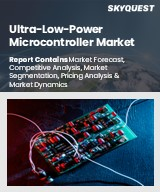
|
시장보고서
상품코드
1598732
초저전력 마이크로컨트롤러 시장 : 주변기기, 패키지 유형, 최종사용자별 - 세계 예측(2025-2030년)Ultra-Low-Power Microcontroller Market by Peripheral Device (Analog Devices, Digital Devices), Packaging Type (16-bit Packaging, 32-bit Packaging, 8-bit packaging), End-Use - Global Forecast 2025-2030 |
||||||
2023년 초저전력 마이크로컴퓨터 시장 규모는 56억 7,000만 달러로 2024년에는 63억 1,000만 달러에 달할 것으로 예상되며, 연평균 11.76% 성장하여 2030년에는 123억 5,000만 달러에 달할 것으로 예측됩니다.
초저전력 마이크로컨트롤러(MCU)의 범위와 정의는 최소한의 에너지 소비로 작동하는 임베디드 시스템을 포괄하며, 배터리 구동 및 에너지 수확 애플리케이션에 필수적입니다. 이러한 MCU는 사물인터넷(IoT), 웨어러블 기술, 스마트 센서의 성장에 필수적이며, 에너지 효율과 배터리 수명 연장이 중요합니다. 그 용도는 헬스케어 기기, 스마트 가전, 산업 자동화, 자동차 전자제품에 이르기까지 매우 광범위합니다. 최종 용도에는 주로 가전제품, 헬스케어, 자동차, 산업 분야가 포함되며, 작동 수명 연장 및 소형화가 요구됩니다. 시장 성장은 스마트 커넥티드 디바이스에 대한 수요 급증, 반도체 기술 발전, 에너지 효율이 높은 시스템 도입 증가에 영향을 받고 있습니다. 기회는 확대되는 IoT 생태계에 있으며, 엣지 컴퓨팅과 연결성 솔루션의 혁신을 활용하여 경쟁 우위를 확보할 수 있습니다. 기업들은 진화하는 시장 수요에 대응하기 위해 강화된 보안 기능, 인공지능, 머신러닝 기능의 통합에 집중해야 합니다. 그러나 시장은 높은 초기 개발 비용, 복잡한 설계 요건, 성능 저하 없이 전력 효율이 높은 솔루션을 통합해야 하는 과제 등의 제약에 직면해 있습니다. 또한, 다양한 세계 시장에서 규제 표준을 극복하는 것은 어려운 일입니다. 연구 개발은 MCU의 에너지 효율을 개선하고, 비용을 절감하며, 서로 다른 플랫폼과 장치 간의 상호 운용성을 촉진하는 데 초점을 맞춰야 합니다. 무선 통신 프로토콜, 저전력 광역 네트워크 기술, 새로운 에너지 수확 기술의 혁신은 유망한 연구 분야입니다. 시장 경쟁은 치열하고 혁신 주도형이며, 급속한 발전과 표준의 진화로 인해 플레이어는 민첩성과 적응력이 요구됩니다. 기업은 전략적으로 R&D에 투자하고 전략적 파트너십을 형성하여 초저전력 마이크로컴퓨터 분야의 특정 고객 요구를 충족하는 맞춤형 솔루션에 집중하여 한 발 앞서 나가야 합니다.
| 주요 시장 통계 | |
|---|---|
| 기준 연도[2023] | 56억 7,000만 달러 |
| 예측 연도[2024] | 63억 1,000만 달러 |
| 예측 연도[2030] | 123억 5,000만 달러 |
| CAGR(%) | 11.76% |
시장 역학 : 빠르게 진화하는 초저전력 마이크로컴퓨터 시장의 주요 시장 인사이트 공개
초저전력 마이크로컨트롤러 시장은 수요와 공급의 역동적인 상호작용에 의해 변화하고 있습니다. 이러한 시장 역학의 변화를 이해함으로써 기업은 정보에 입각한 투자 결정을 내리고, 전략적인 의사결정을 정교화하며, 새로운 비즈니스 기회를 포착할 수 있습니다. 이러한 트렌드를 종합적으로 파악함으로써 기업은 정치적, 지리적, 기술적, 사회적, 경제적 영역 전반에 걸친 다양한 리스크를 줄일 수 있으며, 소비자 행동과 그것이 제조 비용 및 구매 동향에 미치는 영향을 보다 명확하게 이해할 수 있습니다.
- 시장 촉진요인
- 인더스트리 4.0으로 인한 산업 자동화에 대한 투자 증가
- 민생용 전자기기 사용 급증
- 임플란트 의료기기의 급속한 성장
- 시장 억제요인
- 초저전력 마이크로컨트롤러의 설계 및 제조 비용이 높음
- 시장 기회
- 초저전력 마이크로컨트롤러의 기술적 진보
- 전략적 제휴 및 투자 확대
- 시장 과제
- 표준화 부족과 제한적인 조사로 인한 시스템 고장 가능성
Porter's Five Forces : 초저전력 마이크로컨트롤러 시장 공략을 위한 전략적 도구
Porter's Five Forces 프레임워크는 초저전력 마이크로컨트롤러 시장의 경쟁 상황을 이해하는 중요한 도구입니다. Porter's Five Forces 프레임워크는 기업의 경쟁력을 평가하고 전략적 기회를 탐색할 수 있는 명확한 방법을 제공합니다. 이 프레임워크는 기업이 시장 내 세력도를 평가하고 신규 사업의 수익성을 판단하는 데 도움이 됩니다. 이러한 인사이트를 통해 기업은 강점을 활용하고, 약점을 해결하고, 잠재적인 도전을 피하고, 보다 강력한 시장 포지셔닝을 확보할 수 있습니다.
PESTLE 분석 : 초저전력 마이크로컨트롤러 시장의 외부 영향 파악
외부 거시 환경 요인은 초저전력 마이크로컨트롤러 시장의 성과 역학을 형성하는 데 매우 중요한 역할을 합니다. 정치적, 경제적, 사회적, 기술적, 법적, 환경적 요인에 대한 분석은 이러한 영향을 탐색하는 데 필요한 정보를 제공하며, PESTLE 요인을 조사함으로써 기업은 잠재적인 위험과 기회를 더 잘 이해할 수 있습니다. 이러한 분석을 통해 기업은 규제, 소비자 선호도, 경제 동향의 변화를 예측하고 선제적이고 능동적인 의사결정을 내릴 준비를 할 수 있습니다.
시장 점유율 분석 : 초저전력 마이크로컨트롤러 시장에서의 경쟁 상황 파악
초저전력 마이크로컨트롤러 시장의 상세한 시장 점유율 분석을 통해 벤더의 성과를 종합적으로 평가할 수 있습니다. 기업은 수익, 고객 기반, 성장률 등 주요 지표를 비교하여 경쟁적 포지셔닝을 파악할 수 있습니다. 이 분석은 시장의 집중화, 단편화, 통합의 추세를 파악할 수 있으며, 공급업체는 치열한 경쟁 속에서 자신의 입지를 강화할 수 있는 전략적 의사결정을 내리는 데 필요한 인사이트를 얻을 수 있습니다.
FPNV 포지셔닝 매트릭스 : 초저전력 마이크로컨트롤러 시장에서의 공급업체 성과 평가
FPNV 포지셔닝 매트릭스는 초저전력 마이크로컨트롤러 시장에서 벤더를 평가하는 중요한 도구입니다. 이 매트릭스를 통해 비즈니스 조직은 벤더의 비즈니스 전략과 제품 만족도를 기반으로 평가하여 목표에 부합하는 정보에 입각한 의사결정을 내릴 수 있으며, 4개의 사분면으로 벤더를 명확하고 정확하게 세분화하여 전략 목표에 가장 적합한 파트너와 솔루션을 식별할 수 있습니다. 전략 목표에 가장 적합한 파트너와 솔루션을 식별할 수 있습니다.
초저전력 마이크로컨트롤러 시장에서 성공하기 위한 전략 분석 및 권장 사항
초저전력 마이크로컨트롤러 시장 전략 분석은 세계 시장에서 입지를 강화하고자 하는 기업에게 필수적입니다. 주요 자원, 역량 및 성과 지표를 검토함으로써 기업은 성장 기회를 식별하고 개선할 수 있습니다. 이러한 접근 방식을 통해 경쟁 환경의 도전을 극복하고 새로운 비즈니스 기회를 활용하여 장기적인 성공을 거둘 수 있도록 준비할 수 있습니다.
이 보고서는 주요 관심 분야를 포괄하는 시장에 대한 종합적인 분석을 제공합니다.
1. 시장 침투도 : 현재 시장 환경의 상세한 검토, 주요 기업의 광범위한 데이터, 시장 도달 범위 및 전반적인 영향력 평가.
2. 시장 개척도 : 신흥 시장에서의 성장 기회를 파악하고, 기존 분야의 확장 가능성을 평가하며, 미래 성장을 위한 전략적 로드맵을 제공합니다.
3. 시장 다각화 : 최근 제품 출시, 미개척 지역, 업계의 주요 발전, 시장을 형성하는 전략적 투자를 분석합니다.
4. 경쟁 평가 및 정보 : 경쟁 상황을 철저히 분석하여 시장 점유율, 사업 전략, 제품 포트폴리오, 인증, 규제 당국의 승인, 특허 동향, 주요 기업의 기술 발전 등을 검토합니다.
5. 제품 개발 및 혁신 : 향후 시장 성장을 촉진할 것으로 예상되는 첨단 기술, 연구 개발 활동 및 제품 혁신을 강조합니다.
이해관계자들이 충분한 정보를 바탕으로 의사결정을 내릴 수 있도록 다음과 같은 중요한 질문에 대한 답변도 제공합니다.
1. 현재 시장 규모와 향후 성장 전망은?
2. 최고의 투자 기회를 제공하는 제품, 부문, 지역은 어디인가?
3. 시장을 형성하는 주요 기술 동향과 규제의 영향은?
4. 주요 벤더의 시장 점유율과 경쟁 포지션은?
5. 벤더의 시장 진입 및 철수 전략의 원동력이 되는 수익원과 전략적 기회는 무엇인가?
목차
제1장 서문
제2장 조사 방법
제3장 주요 요약
제4장 시장 개요
제5장 시장 인사이트
- 시장 역학
- 성장 촉진요인
- 성장 억제요인
- 기회
- 과제
- 시장 세분화 분석
- Porter's Five Forces 분석
- PESTEL 분석
- 정치
- 경제
- 사회
- 기술
- 법률
- 환경
제6장 초저전력 마이크로컨트롤러 시장 주변기기별
- 아날로그 디바이스
- 디지털 디바이스
제7장 초저전력 마이크로컨트롤러 시장 : 패키징 유형별
- 16비트 패키지
- 32비트 패키지
- 8비트 패키지
제8장 초저전력 마이크로컨트롤러 시장 : 최종 용도별
- 항공우주 및 방위
- 자동차
- 가전
- 헬스케어
- 제조업
- 미디어와 엔터테인먼트
- 서버와 데이터센터
- 통신
제9장 아메리카의 초저전력 마이크로컨트롤러 시장
- 아르헨티나
- 브라질
- 캐나다
- 멕시코
- 미국
제10장 아시아태평양의 초저전력 마이크로컨트롤러 시장
- 호주
- 중국
- 인도
- 인도네시아
- 일본
- 말레이시아
- 필리핀
- 싱가포르
- 한국
- 대만
- 태국
- 베트남
제11장 유럽, 중동 및 아프리카의 초저전력 마이크로컨트롤러 시장
- 덴마크
- 이집트
- 핀란드
- 프랑스
- 독일
- 이스라엘
- 이탈리아
- 네덜란드
- 나이지리아
- 노르웨이
- 폴란드
- 카타르
- 러시아
- 사우디아라비아
- 남아프리카공화국
- 스페인
- 스웨덴
- 스위스
- 터키
- 아랍에미리트
- 영국
제12장 경쟁 상황
- 시장 점유율 분석 2023
- FPNV 포지셔닝 매트릭스, 2023
- 경쟁 시나리오 분석
- 전략 분석과 제안
기업 리스트
- Analog Devices, Inc.
- Cypress Semiconductor Corporation
- Intel Corporation
- Marvell Technology Group
- Maxim Integrated
- Microchip Technology Inc.
- Nuvoton Technology Corporation
- NXP Semiconductors N.V.
- Renesas Electronics Corporation
- Seiko Epson Corporation
- Semiconductor Components Industries, LLC
- Silicon Laboratories, Inc.
- STMicroelectronics N.V.
- Texas Instrument Inc.
- Toshiba Corporation
The Ultra-Low-Power Microcontroller Market was valued at USD 5.67 billion in 2023, expected to reach USD 6.31 billion in 2024, and is projected to grow at a CAGR of 11.76%, to USD 12.35 billion by 2030.
The scope and definition of ultra-low-power microcontrollers (MCUs) encompass embedded systems that operate with minimal energy consumption, vital for battery-powered and energy-harvesting applications. These MCUs are essential for the growth of the Internet of Things (IoT), wearable technology, and smart sensors, where energy efficiency and extended battery life are critical. Their applications cover a wide range, from healthcare devices and smart home appliances to industrial automation and automotive electronics. The end-use scope predominantly includes consumer electronics, healthcare, automotive, and industrial sectors that demand prolonged operational lifetime and small form factors. Market growth is influenced by the surging demand for smart, connected devices, advancements in semiconductor technology, and the increasing implementation of energy-efficient systems. Opportunities lie in the expanding IoT ecosystem, where innovation in edge computing and connectivity solutions can be leveraged for competitive advantage. Companies should focus on integrating enhanced security features, artificial intelligence, and machine learning capabilities to cater to the evolving market demands. However, the market faces limitations such as high initial development costs, complex design requirements, and the challenge of integrating power-efficient solutions without compromising performance. Additionally, navigating regulatory standards in varied global markets can be daunting. Research and development should concentrate on improving the energy efficiency of MCUs, reducing costs, and fostering interoperability across different platforms and devices. Innovations in wireless communication protocols, low-power wide-area network technologies, and novel energy harvesting techniques are promising areas for exploration. The nature of the market is highly competitive and innovation-driven, with rapid advancements and evolving standards demanding agility and adaptation from players. Companies must strategically invest in R&D and form strategic partnerships to stay ahead, focusing on customizing solutions to meet specific customer needs in the ultra-low-power microcontroller space.
| KEY MARKET STATISTICS | |
|---|---|
| Base Year [2023] | USD 5.67 billion |
| Estimated Year [2024] | USD 6.31 billion |
| Forecast Year [2030] | USD 12.35 billion |
| CAGR (%) | 11.76% |
Market Dynamics: Unveiling Key Market Insights in the Rapidly Evolving Ultra-Low-Power Microcontroller Market
The Ultra-Low-Power Microcontroller Market is undergoing transformative changes driven by a dynamic interplay of supply and demand factors. Understanding these evolving market dynamics prepares business organizations to make informed investment decisions, refine strategic decisions, and seize new opportunities. By gaining a comprehensive view of these trends, business organizations can mitigate various risks across political, geographic, technical, social, and economic domains while also gaining a clearer understanding of consumer behavior and its impact on manufacturing costs and purchasing trends.
- Market Drivers
- Increasing investments made towards industry automation with Industry 4.0
- Surging utilization of consumer electronic devices
- Rapid growth witnessed in the use of implantable medical devices
- Market Restraints
- High cost of designing and manufacturing ultra-low-power microcontrollers
- Market Opportunities
- Technological advancements in ultra-low-power microcontrollers
- Increasing strategic alliances and investments
- Market Challenges
- Lack of standardization and possibility of failure of the system due to limited research
Porter's Five Forces: A Strategic Tool for Navigating the Ultra-Low-Power Microcontroller Market
Porter's five forces framework is a critical tool for understanding the competitive landscape of the Ultra-Low-Power Microcontroller Market. It offers business organizations with a clear methodology for evaluating their competitive positioning and exploring strategic opportunities. This framework helps businesses assess the power dynamics within the market and determine the profitability of new ventures. With these insights, business organizations can leverage their strengths, address weaknesses, and avoid potential challenges, ensuring a more resilient market positioning.
PESTLE Analysis: Navigating External Influences in the Ultra-Low-Power Microcontroller Market
External macro-environmental factors play a pivotal role in shaping the performance dynamics of the Ultra-Low-Power Microcontroller Market. Political, Economic, Social, Technological, Legal, and Environmental factors analysis provides the necessary information to navigate these influences. By examining PESTLE factors, businesses can better understand potential risks and opportunities. This analysis enables business organizations to anticipate changes in regulations, consumer preferences, and economic trends, ensuring they are prepared to make proactive, forward-thinking decisions.
Market Share Analysis: Understanding the Competitive Landscape in the Ultra-Low-Power Microcontroller Market
A detailed market share analysis in the Ultra-Low-Power Microcontroller Market provides a comprehensive assessment of vendors' performance. Companies can identify their competitive positioning by comparing key metrics, including revenue, customer base, and growth rates. This analysis highlights market concentration, fragmentation, and trends in consolidation, offering vendors the insights required to make strategic decisions that enhance their position in an increasingly competitive landscape.
FPNV Positioning Matrix: Evaluating Vendors' Performance in the Ultra-Low-Power Microcontroller Market
The Forefront, Pathfinder, Niche, Vital (FPNV) Positioning Matrix is a critical tool for evaluating vendors within the Ultra-Low-Power Microcontroller Market. This matrix enables business organizations to make well-informed decisions that align with their goals by assessing vendors based on their business strategy and product satisfaction. The four quadrants provide a clear and precise segmentation of vendors, helping users identify the right partners and solutions that best fit their strategic objectives.
Strategy Analysis & Recommendation: Charting a Path to Success in the Ultra-Low-Power Microcontroller Market
A strategic analysis of the Ultra-Low-Power Microcontroller Market is essential for businesses looking to strengthen their global market presence. By reviewing key resources, capabilities, and performance indicators, business organizations can identify growth opportunities and work toward improvement. This approach helps businesses navigate challenges in the competitive landscape and ensures they are well-positioned to capitalize on newer opportunities and drive long-term success.
Key Company Profiles
The report delves into recent significant developments in the Ultra-Low-Power Microcontroller Market, highlighting leading vendors and their innovative profiles. These include Analog Devices, Inc., Cypress Semiconductor Corporation, Intel Corporation, Marvell Technology Group, Maxim Integrated, Microchip Technology Inc., Nuvoton Technology Corporation, NXP Semiconductors N.V., Renesas Electronics Corporation, Seiko Epson Corporation, Semiconductor Components Industries, LLC, Silicon Laboratories, Inc., STMicroelectronics N.V., Texas Instrument Inc., and Toshiba Corporation.
Market Segmentation & Coverage
This research report categorizes the Ultra-Low-Power Microcontroller Market to forecast the revenues and analyze trends in each of the following sub-markets:
- Based on Peripheral Device, market is studied across Analog Devices and Digital Devices.
- Based on Packaging Type, market is studied across 16-bit Packaging, 32-bit Packaging, and 8-bit packaging.
- Based on End-Use, market is studied across Aerospace & Defense, Automotive, Consumer Electronics, Healthcare, Manufacturing, Media & Entertainment, Servers & Data Centers, and Telecommunications.
- Based on Region, market is studied across Americas, Asia-Pacific, and Europe, Middle East & Africa. The Americas is further studied across Argentina, Brazil, Canada, Mexico, and United States. The United States is further studied across California, Florida, Illinois, New York, Ohio, Pennsylvania, and Texas. The Asia-Pacific is further studied across Australia, China, India, Indonesia, Japan, Malaysia, Philippines, Singapore, South Korea, Taiwan, Thailand, and Vietnam. The Europe, Middle East & Africa is further studied across Denmark, Egypt, Finland, France, Germany, Israel, Italy, Netherlands, Nigeria, Norway, Poland, Qatar, Russia, Saudi Arabia, South Africa, Spain, Sweden, Switzerland, Turkey, United Arab Emirates, and United Kingdom.
The report offers a comprehensive analysis of the market, covering key focus areas:
1. Market Penetration: A detailed review of the current market environment, including extensive data from top industry players, evaluating their market reach and overall influence.
2. Market Development: Identifies growth opportunities in emerging markets and assesses expansion potential in established sectors, providing a strategic roadmap for future growth.
3. Market Diversification: Analyzes recent product launches, untapped geographic regions, major industry advancements, and strategic investments reshaping the market.
4. Competitive Assessment & Intelligence: Provides a thorough analysis of the competitive landscape, examining market share, business strategies, product portfolios, certifications, regulatory approvals, patent trends, and technological advancements of key players.
5. Product Development & Innovation: Highlights cutting-edge technologies, R&D activities, and product innovations expected to drive future market growth.
The report also answers critical questions to aid stakeholders in making informed decisions:
1. What is the current market size, and what is the forecasted growth?
2. Which products, segments, and regions offer the best investment opportunities?
3. What are the key technology trends and regulatory influences shaping the market?
4. How do leading vendors rank in terms of market share and competitive positioning?
5. What revenue sources and strategic opportunities drive vendors' market entry or exit strategies?
Table of Contents
1. Preface
- 1.1. Objectives of the Study
- 1.2. Market Segmentation & Coverage
- 1.3. Years Considered for the Study
- 1.4. Currency & Pricing
- 1.5. Language
- 1.6. Stakeholders
2. Research Methodology
- 2.1. Define: Research Objective
- 2.2. Determine: Research Design
- 2.3. Prepare: Research Instrument
- 2.4. Collect: Data Source
- 2.5. Analyze: Data Interpretation
- 2.6. Formulate: Data Verification
- 2.7. Publish: Research Report
- 2.8. Repeat: Report Update
3. Executive Summary
4. Market Overview
5. Market Insights
- 5.1. Market Dynamics
- 5.1.1. Drivers
- 5.1.1.1. Increasing investments made towards industry automation with Industry 4.0
- 5.1.1.2. Surging utilization of consumer electronic devices
- 5.1.1.3. Rapid growth witnessed in the use of implantable medical devices
- 5.1.2. Restraints
- 5.1.2.1. High cost of designing and manufacturing ultra-low-power microcontrollers
- 5.1.3. Opportunities
- 5.1.3.1. Technological advancements in ultra-low-power microcontrollers
- 5.1.3.2. Increasing strategic alliances and investments
- 5.1.4. Challenges
- 5.1.4.1. Lack of standardization and possibility of failure of the system due to limited research
- 5.1.1. Drivers
- 5.2. Market Segmentation Analysis
- 5.3. Porter's Five Forces Analysis
- 5.3.1. Threat of New Entrants
- 5.3.2. Threat of Substitutes
- 5.3.3. Bargaining Power of Customers
- 5.3.4. Bargaining Power of Suppliers
- 5.3.5. Industry Rivalry
- 5.4. PESTLE Analysis
- 5.4.1. Political
- 5.4.2. Economic
- 5.4.3. Social
- 5.4.4. Technological
- 5.4.5. Legal
- 5.4.6. Environmental
6. Ultra-Low-Power Microcontroller Market, by Peripheral Device
- 6.1. Introduction
- 6.2. Analog Devices
- 6.3. Digital Devices
7. Ultra-Low-Power Microcontroller Market, by Packaging Type
- 7.1. Introduction
- 7.2. 16-bit Packaging
- 7.3. 32-bit Packaging
- 7.4. 8-bit packaging
8. Ultra-Low-Power Microcontroller Market, by End-Use
- 8.1. Introduction
- 8.2. Aerospace & Defense
- 8.3. Automotive
- 8.4. Consumer Electronics
- 8.5. Healthcare
- 8.6. Manufacturing
- 8.7. Media & Entertainment
- 8.8. Servers & Data Centers
- 8.9. Telecommunications
9. Americas Ultra-Low-Power Microcontroller Market
- 9.1. Introduction
- 9.2. Argentina
- 9.3. Brazil
- 9.4. Canada
- 9.5. Mexico
- 9.6. United States
10. Asia-Pacific Ultra-Low-Power Microcontroller Market
- 10.1. Introduction
- 10.2. Australia
- 10.3. China
- 10.4. India
- 10.5. Indonesia
- 10.6. Japan
- 10.7. Malaysia
- 10.8. Philippines
- 10.9. Singapore
- 10.10. South Korea
- 10.11. Taiwan
- 10.12. Thailand
- 10.13. Vietnam
11. Europe, Middle East & Africa Ultra-Low-Power Microcontroller Market
- 11.1. Introduction
- 11.2. Denmark
- 11.3. Egypt
- 11.4. Finland
- 11.5. France
- 11.6. Germany
- 11.7. Israel
- 11.8. Italy
- 11.9. Netherlands
- 11.10. Nigeria
- 11.11. Norway
- 11.12. Poland
- 11.13. Qatar
- 11.14. Russia
- 11.15. Saudi Arabia
- 11.16. South Africa
- 11.17. Spain
- 11.18. Sweden
- 11.19. Switzerland
- 11.20. Turkey
- 11.21. United Arab Emirates
- 11.22. United Kingdom
12. Competitive Landscape
- 12.1. Market Share Analysis, 2023
- 12.2. FPNV Positioning Matrix, 2023
- 12.3. Competitive Scenario Analysis
- 12.4. Strategy Analysis & Recommendation
Companies Mentioned
- 1. Analog Devices, Inc.
- 2. Cypress Semiconductor Corporation
- 3. Intel Corporation
- 4. Marvell Technology Group
- 5. Maxim Integrated
- 6. Microchip Technology Inc.
- 7. Nuvoton Technology Corporation
- 8. NXP Semiconductors N.V.
- 9. Renesas Electronics Corporation
- 10. Seiko Epson Corporation
- 11. Semiconductor Components Industries, LLC
- 12. Silicon Laboratories, Inc.
- 13. STMicroelectronics N.V.
- 14. Texas Instrument Inc.
- 15. Toshiba Corporation



















